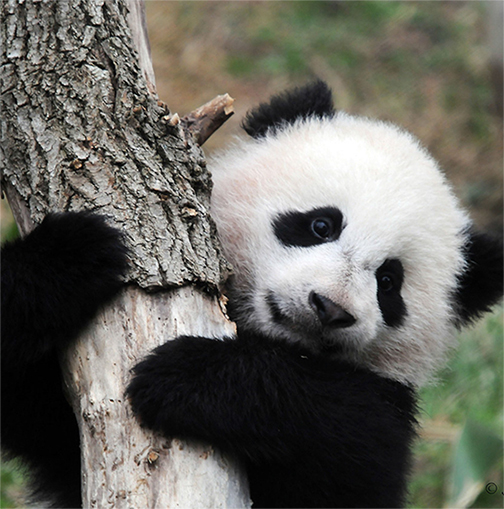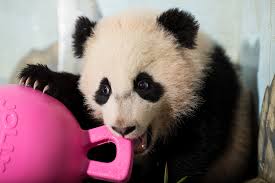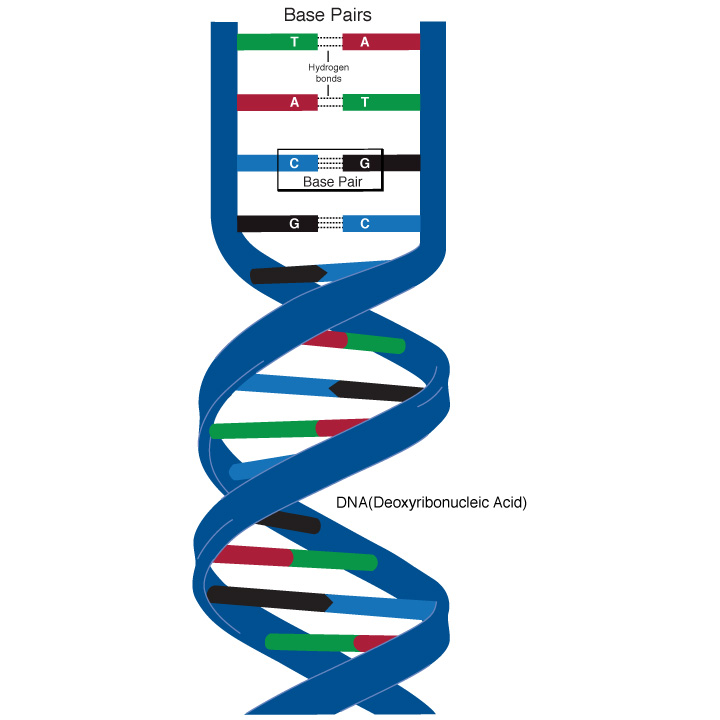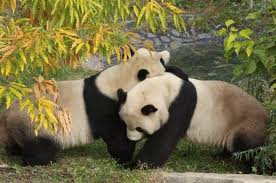Bringing Up Bao Bao
Anticipation mounted before the birth of Bao Bao the giant panda at the National Zoo. With populations dwindling to dangerously low levels worldwide, the zoo was eager to see another bear added to the family. Consequently, Bao Bao's healthy arrival last August was cause for celebration. Michelle Obama made a video when she was named, and crowds gathered at the zoo to catch a glimpse of her sleepy, furry form. But at the same time, the panda's birth was shrouded in a dose of mystery: both the baby's sex and the identity of its father were unknown.

(Image courtesy of mnh.si.edu.)
With scientists at the zoo scrutinizing the pandas day and night, it seems surprising that they could not identify the father. Really, given how few pandas are walking around these days, how many options could there have been?
The catch is that Bao Bao's mother, Mei Xiang, was artificially inseminated by scientists with a mixture of sperm from two different pandas: Tian Tian, who lives in the National Zoo, and Gao Gao, who lives in San Diego. (Gao Gao's sperm was frozen and shipped across the country.) Because it is important to successfully breed these endangered bears, and because pandas are only ready to mate once a year, the scientists used sperm from both males in order to raise the probability that Mei Xiang would become pregnant. Either panda -- Tian Tian or Gao Gao -- could have been the father.
The question of Bao Bao's sex is less unusual. That's because a giant panda displays no outward sign of its gender until at least age three. When it is born, it is small and long and smooth, and looks a lot like a stick of butter. (Case in point: Tai Shan, a giant panda born at the National Zoo back in 2005, was nicknamed "Butterstick.") As the Atlanta Zoo discovered when it mistakenly identified three pandas as male instead of female, determining the sex of these babies is easier said than done.

Bao Bao with her pink ball. At her birth, she was much smaller and completely hairless. (Image from nationalzoo.si.edu.)
Right after Bao Bao was born, the National Zoo set out to determine the answers. Nancy McInerney, a biologist and laboratory manager for the Center for Conservation and Evolutionary Genetics, is the scientist who identified Bao Bao's sex and paternity. In a talk last week at the National Museum of Natural History called "Science at the edge: Who is Bao Bao's Panda Daddy?," she explained how she did it.
She begins with four DNA samples: one from the mother, one from the baby, and one from each possible father. Panda DNA is a lot like human DNA. There are only four bases total that comprise it -- A, C, T, and G -- but their arrangement in a specific order stores information for a body like code for a computer.
One long strand of bases has a partner strand closely bonded to it. Because of the way the bases are shaped, C bases may only bond with G, and A bases may only bond with T. This means that if you only had the sequence for one of the two strands -- GAT, for example -- you could immediately determine the partner strand's sequence: C, which fits with the first G base, then T which binds to the A, and then A, which binds to the final T.
Human eyes are not alone in being able to put together a chain of DNA if given one sequence to build upon. When your body needs to copy its DNA -- which it does constantly -- the molecular machinery inside you uses the same principles to build new strands. Given just one half of a DNA double helix, your body can create the other half.
McInerney has a small sample of DNA from each panda, but she needs many thousands of copies of it so that she can use it to determine the paternity. To quickly multiply the amount of DNA she has, she takes advantage of the molecular machinery's ability to put together new strands. Because extra material surrounds the bases in the double helix, she must prize apart the two strands in order to expose their codes. To do this, she puts the DNA in a machine and heats it. At a high enough temperature, the bonds holding the strands together snap and the two chains separate.

A double helix is composed of two strands of DNA. The strands are complementary to one another. They can be separated by applying heat, and one strand can be used as a template for the other. Image from https://unlockinglifescode.org/, credit to Darryl Leja, NHGRI.
Her goal is to make a huge number of copies of this particular strand of DNA, so McInerney heads to the molecular Xerox machine: polymerase. This little molecule slides along a strand that has been severed from its partner. Using any free-floating building blocks lying around and the first chain as its template, polymerase is able to construct the second strand.
But polymerase can't jump into action immediately. Like a baby that needs help taking its first few steps in order to continue walking on its own, polymerase cannot initiate a partner chain itself; it can only continue to build upon one that has already been started. To give polymerase a starting point, McInerney adds a small piece of DNA that is only five or six bases long, called a primer, which acts as the very beginning of the partner strand. When added to the mix, the primer binds to the long, lonely single strand.
And...it's off! Polymerase, lightning fast, starts building at the primer and races towards the finish line, flying along the chain as it adds bases, constructing the second strand from the ground up. Thousands of bases later, the severed strand has a brand new chain bonded to it that is just as complementary as its original partner was.
This technique, called a polymerase chain reaction (PCR), is the one McInerney used to make copies of the four pandas' DNA. Using PCR, one panda DNA strand becomes two. Those two sets of strands can then be heated, severed, and built upon. Two strands become four, which become eight and then thousands.
Now that she has a truckload of double stranded DNA copies for each panda, McInerney has enough material to determine whether Bao Bao's DNA is more similar to Tian Tian's or Gao Gao's. Because genetic material is inherited from both parents, Bao Bao's DNA fragments should be the same size as either Tian Tian's or Gao Gao's, but not both.
Using gel electrophoresis, which is a topic for another time, McInerney compared the DNA fragment sizes among Bao Bao and Mei Xiang, Tian Tian, and Gao Gao. What she learned from this analysis made her the first person in the world to know who fathered the famous baby panda. And...drumroll please...the father is Tian Tian!

Mei Xiang and Tian Tian. Image courtesy of newsdesk.si.edu.
McInerney used similar techniques to peer into Bao Bao's chromosomes. She discovered that Bao Bao has two X chromosomes and no Y, making her female.
Without PCR and our knowledge of genetics, we might still be in the dark about Bao Bao. The revelation of her father's identity is especially important for researchers who are using pedigrees in order to evaluate the genetic relationships among all the pandas in captivity. One of their hopes in breeding giant pandas in the US that will eventually be sent back to China is to create a diverse population of these endangered bears. We don't want panda clones running around the forests of China, because if they all have the same genetic weaknesses, they are more susceptible to extinction. Knowing what genetic stock Bao Bao comes from is important to scientists who might potentially breed her down the line.
And I'd like to think the knowledge is important to Tian Tian, too.
To learn more about genomes and genetics in medicine and society, check out the National Museum of Natural History's exhibit "Genome: Unlocking Life's Code," which is available only until September.
